Hunting the Unicorn III
Reviewing 'Cosmos in Miniature', 'Tarot Symbolism' & 'Tarot and the Millennium'
Part VI in The Meaning of Tarot Series
Unveiling the Renaissance Metaphor
Occultation
Hunting the Unicorn
Gertrude Moakley & The Triumphs of Petrarch
Hunting the Unicorn II
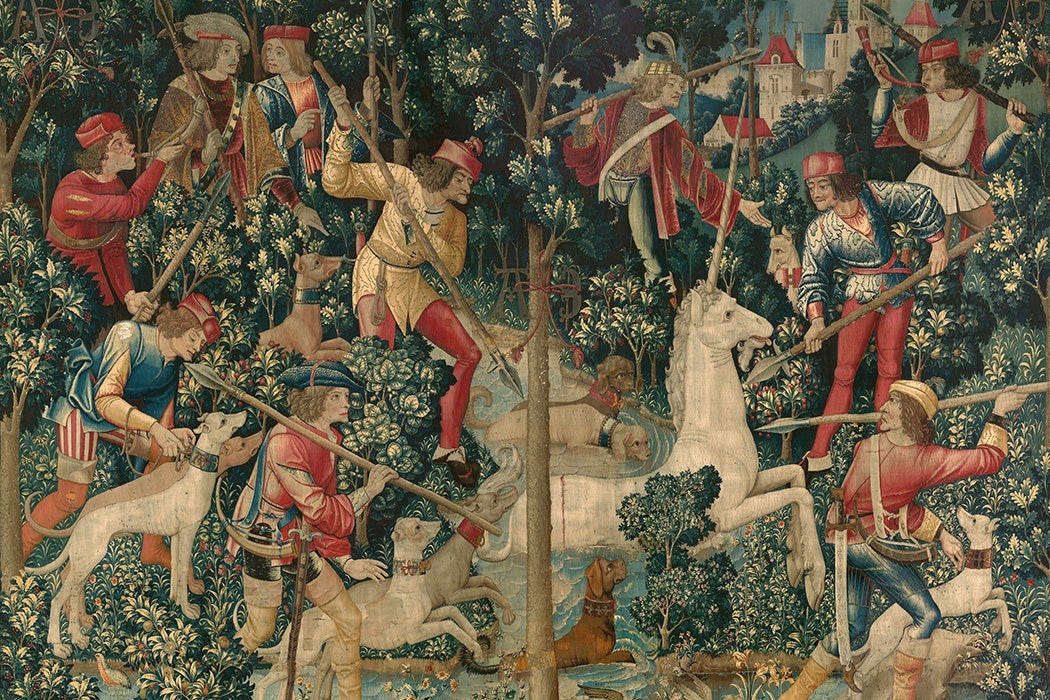
Continuing our survey of books that proposed novel theories on tarot iconography we pick up where we left off in the mid-80’s. In this installment we have a complicated astrology theory, a Frankensteinian amalgamation of theories and a theory based on the book of Revelation - but not how you might expect!
1985 - John Shephard, The Tarot Trumps: Cosmos in Miniature
I mentioned this book at the end of the last article, the author was an astrology expert and a member of various astrology organizations as well as the International Playing Card Society. This book belongs on this list as it is one of the few times that a novel theory has ever been proposed. I still haven’t gotten my hands on a copy of this book and I doubt I will - it’s not online, it’s out of print and only available second hand at a collector price. However, I have been able to able to gather enough information about it from discussions and sample pages that I believe we can safely rule this one out, let me explain:
Above is a picture of the page where a chart was provided summing up the book’s central theory. As you can see the trumps are divided into a 3 x 7 structure but beyond that it is convoluted as all hell. The author had based his theory in part on the Book of the Seven Planet which was a popular block book in the XV century. This block book contained a poem describing various occupations and archetypes as the children of one of the seven classical planets. This blockbook contains a few tarot cognates such as Juggler as a Child of the Moon and the Wrestlers on the Sun card . On it’s face it’s not too far fetched to think that tarot may have borrowed more than a couple images from The Children of the Planets however this chart is a bit much. From what I understand ‘The Triple Goddess of the Moon’ is meant to be an explanation for the cards in the Visconti-Sforza deck that were added later. Occum and his razor prefer the solution that makes the least assumptions, this theory just might take the cake for making the MOST assumptions.
Have you read Cosmos in Miniature? What did you think of it?
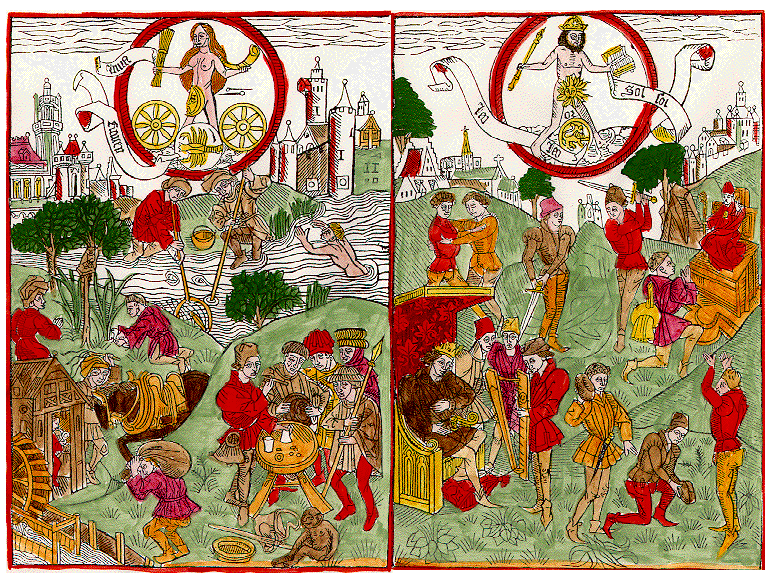
1986 - Robert V. O’Neill, Tarot Symbolism - Archive
This next book was essentially the landmark study into theories of esoteric tarot and nearly 40 years on no other work has come close to encompassing it’s exhaustive depth. Despite being titled Tarot Symbolism this was more appropriately a history book on the western esoteric tradition with bits of tarot tossed in here and there. More to my point, this book has no illustrations which is a bit of an oddity for a book critiquing a visual medium. The author was a PHD research scientist and he structured this book a bit like a textbook with each branch of the esoteric tradition getting it’s own dedicated chapter or ‘study’. His general viewpoint upheld de Gébelin that Tarot is an ancient book of wisdom which he believed was the creation of heretical dualist cults who had chosen the iconography from a diverse array of philosophies.
What this book did well was bring together a ton of information on all of the various theories related to tarot’s origins and iconography. In the second chapter the author gives a brief run down on many of the theories of tarot’s origins: Egypt, Gypsies, Secret Cathar Watermarks, Paul Foster Case’s Fez Morocco Hypothesis, Moakley’s Triumphs and so on. This sets the tone for the rest of the book as we read through a series of studies each focused on a different aspect of the western esoteric tradition.
By virtue of each tradition getting it’s own chapter they also get a section of each other tradition’s chapter devoted to discussing their relationship, effectively truncating each discussion across several chapters. This book was a bit of a rough read as these concepts kept getting brought back up again and again. I feel like it took subjects that I normally find deeply interesting, such as gnosticism and medieval heresies, and flogged them to death repeatedly.
Besides structure I had one other major complaint with this book and that was the author’s tendency to front load his arguments by passing off modern interpretations as the Renaissance viewpoint. For instance, in the book’s introduction he states that the ‘images’ (textual descriptions as there are no images in this book) are from the Tarot de Marseilles but then in the first chapter when he introduces the Tarot trumps the Fool has an alligator, the Papess has pillars and we enter ‘The Garden of Venus’ for the Empress - these are all references to elements that don’t appear until the nineteenth century and nowhere is that clarified that for the uninitiated. This was not a good start and he does this sort of thing throughout.At one point, he even cited the Gnostic text Pistis Sophia and drew parallels between it and the Papess and World cards [p. 134], even though Pistis Sophia wasn’t discovered until 1773 and thus would not have been known during the Renaissance.
While most of this book is spent discussing tangential bits of history there are nuggets of wisdom hidden deep within. Reading through Tarot Symbolism was a lot like performing the Abremelin ritual where instead of demons you summon forth all of these various tarot theories and have to fight them off one by one (but then they keep coming back in weaker forms because this book is repetitive like that). Survive until the end and you just might be rewarded.
In chapter 9 there is a detailed list of art cognates for each card where he was able to find similar pieces for every one of the Tarot trumps except for the Moon. One thing I noticed that he missed were all of the ones from the Book of the Seven Planets so he likely didn’t read Cosmos in Miniature. Other that it is a solid list that mostly still holds up. As this book has no pictures it is much more readable nowadays as you can find most of the references online.
In the same chapter there is a detailed guide to medieval watermarks that are similar to the Tarot images which was drawn from Harold Bayley’s The Lost Language of Symbolism ( A fascinating book in and of itself, Archive: Vol. I , Vol. II ). This was one of those rewarding nuggets of wisdom that I mentioned. While O’Neill rightly concludes that the watermarks were negligible at best in their relation to Tarot, their mere presentation adds so much context into the puns and word play that we find embedded in the iconography of the cards.
During the study on Christian Mysticism, the author explained his advocacy for the all-in approach to medieval symbolism:
“The first point we must establish is that the Tarot is not simply reducible to any one symbolic system. Christian mysticism is incorporated in the cards, but one will find the concepts of the mysticism clearly symbolized in the cards fully one-third of the Trumps do not fit at all (i.e., cards one-four, seven-eight, fourteen). Thus, although we may argue that some of the basic themes of the Tarot can be explained by the mystical tradition of Christianity, it certainly does not explain everything. We will need all the symbolic systems present—a whole series of studies to approach anything like a complete understanding of the symbols.
Nevertheless, the contribution of Christian mysticism is clear.” [Pg. 174]
This division of all of the syncretic Renaissance philosophies into neat little exonymic chunks was one of the more difficult-to-follow aspects of this book. On one hand he seems to argue that we need all of these different systems but throughout the book many of the Renaissance thinkers that were discussed check multiple of these boxes. You can effectively reduce the number of symbolic systems down to Christian Mysticism using Tarot Symbolism’s own studies:
“It is clear that many elements of [Persian Dualist] mythology were accepted and incorporated into the syncretisitic religions, Christianity and Judaism were no exceptions.” [Pg. 129]
“Like many of the other Greek philosophers Aristotle was a dualist.” [Pg. 129]
“In the New Testament, Paul acknowledges that his readers are familiar with these pagan systems and argues that Christianity is the new Mystery Religion, now made open and available to everyone. Baptism is the new initiation, the death and rebrith in Christ. Paul uses the word “Gnosis” to signify the massage of Christ which awakens men’s spirits and makes possible their salvation.
Probably the clearest indication of Gnostic influence in the New Testament can be found in John, who identifies Christ as the Logos (i.e., Word) or first emanation of God and also as Light, or principle of Good: [John 1:1-5] In the beginning was the Word, the Word was with God and the Word was God … Through Him all things came to be … All that came to be had life in it and that life was the light of men, a light that shines in the dark, a light that darkness could not overpower. Although there is still debate on the matter, it seems that Christianity adopted much from the Mystery Religions. For example, it accepted the three stages of the mystical journey: purification, illumination and union.” [Pg. 138-139]“The assimilation of Christianity into the tarot is clear in many cards. The Christian images include the Pope and Hermit, often shown as a Benedictine or Franciscan monk. Other cards such as the Devil and the Last Judgment also suggest Christian sources.” [Pg. 162]
“It was through St. Augustine that Neoplatonism was passed to the Middle Ages. His Neoplatonic philosophy became Christian orthodoxy. In his writings he praises Plotinean philosophy as very close to Christian truth.” [Pg. 167]
“The greatest achievements of scholastic theology are centered about Thomas Aquinas in the thirteenth century. Taught by Albert the Great (1200-1280), an avowed Neoplatonist, Thomas owed much to the Neoplatonic tradition.” [Pg. 170]
If Christianity absorbed Dualist Eschatology in the early days, every educated person in the middle ages read Aristotle and the most influential medieval Christian writers were heavily influenced by Neoplatonism, isn’t it overcomplicating things a bit to deconstruct all of these elements? It is worth noting that this book argues extensively that the contrast in the ‘dark’ and ‘light’ cards constitutes a harmony of opposites and is therefore proof of dualistic heresy and alchemic influence so there remains that consideration.
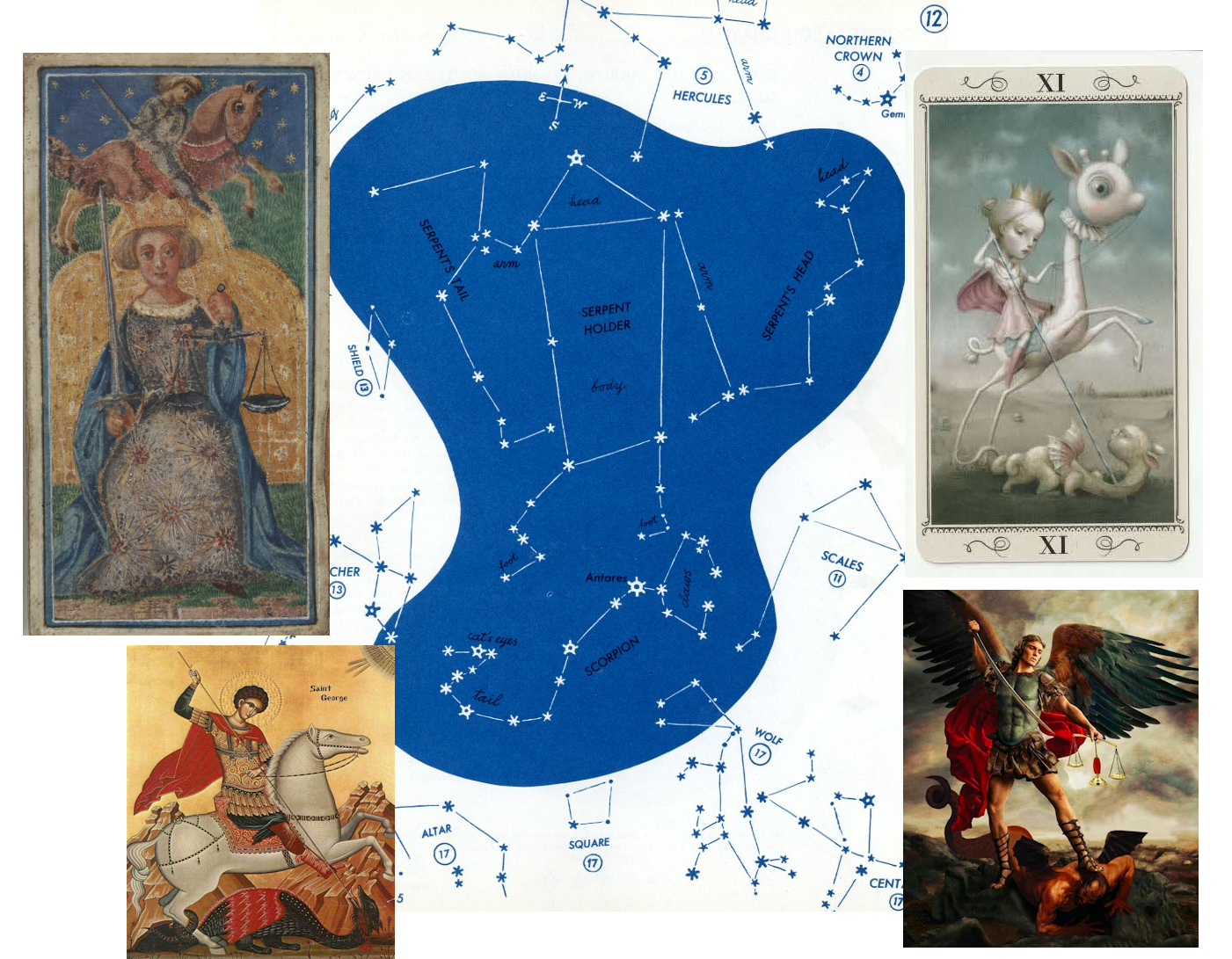
Now, to break down the cards that were stated above to seemingly not fit:
1-4, sure, these are from secular art and reflect medieval culture. For the record I believe Tarot to have been a secular product from a deeply religious society.
7 The Chariot is from Plato’s Phaedrus but could have been informed by Thomas Aquinas as well. Besides the game of triumphs needed a triumphal car.
8 and 14, two of the virtues were an interesting choice for cards not fitting in with Christian Mysticism. Later in the book he reasons that the virtues together form a larger alchemical metaphor:
“The placement of the cards according to the Tarot de Marseilles ordering indicates Justice as the weighing of the alchemical ingredients, Fortitude as the overcoming of the alchemical Green Lion and Temperance as the alchemical process of distillation. These interpretations appear legitimate and are substantiated by similar imagery in the alchemical texts.” [Pg. 296]
To his credit this is a cool concept and it is part of a broader argument for TDM primacy which I also support. This kind of super deep symbolism is highly speculative. If Fortitude is concealing The Green Lion he is hidden underneath a common image as well as a broader astrological layer. As far as other meanings for the second act, Tarot Symbolism only mentions Boccaccio one time and then it’s in relation to Petrarch [Pg. 69]. While I’m not completely sold on this being an alchemical metaphor, this is one of the better explanations that I have read for the placement of the virtues in the TDM.

He has a similar argument about placement regarding the Judgement and World cards:
“If, as we hope to establish in due course, the heresies influenced the designers, then we must be prepared to look for interpretations which reverse the meaning of essentially orthodox symbols. The details of the cards, or their ordering, might disguise an underlying dualist and heretical system. Take, for example, the position of the Judgment card in the deck. If this card is last in the series, as it is in Bolognese decks, the symbol represents the angel Gabriel calling the just to their reward. This establishes the orthodoxy of the deck, since the Pessimistic Gnostics did not believe in the Last Judgment and Resurrection. If the card lies next to last, it could represent the call to mystical union, the call out of the tomb of the body. This is the gnostic allegorical interpretation of the Last Judgment. This is the meaning they affirmed when asked if they believed in the Resurrection of the dead. Changing the position of the card in the deck completely changes its significance. The cards would seem innocent enough on the surface, but an allegorical interpretation, determined only by the position of the card, would reveal an entirely different meaning.” [Pg. 191]
I think the placement of these cards is best easily explained by the Book of Revelation. Chapter 20 is the Judgment and Chapter 21 is the new world and being called to a mystical union with Christ: [Revelation 21:1-3]“And I saw a new heaven and a new earth: for the first heaven and the first earth were passed away; and there was no more sea.2 And I John saw the holy city, new Jerusalem, coming down from God out of heaven, prepared as a bride adorned for her husband.” I’m not really seeing how what is happening in these verses is so different than what Tarot Symbolism is calling the gnostic allegorical interpretation.
Furthermore, a careful study of Revelation will expose one to all of the mystery traditions included in Tarot Symbolism. Revelation borrows heavily from the Sibylline Oracles, it is loaded with Dualism and Zoroastrian inspired fire symbolism, an obsession with numbers and gematria, not to mention that the authors were adepts at Hellenic Astrology and practiced the mysteries themselves.
After all one would have just needed to have followed the Revelation authors’ example to have been every bit the kind of magus that Tarot Symbolism speaks of. Joachim of Flora basically did this and he was very respected. Richard of Lionheart sought his counsel on the way to the Holy Land and Dante placed him in Paradise as a Doctor of the Church.
The author made his feeling clears on interpretations such as Dummett’s Triumphal Sampler in a short section called The Theory of No Symbolism:
“The result of this modern attitude is to consider the Tarot as merely a game. This keeps research a safe "arm’s distance" from occultism. But since it maintains the “no symbolism” attitude as the safest plan, it places the burden of proof on the investigator of symbolism to demonstrate that there is any symbolism to be explained. Thus, we must take up this gauntlet before any of the studies in this series can be seriously considered by modern Tarot scholars.” [Pg. 89]
Most of this short section was wasted on building strawmen when it could have been so much more. Granted Piscina’s essay wouldn’t be discovered until a few years after Tarot Symbolism was published (and a few decades more until it’s implications were considered) - reading the trump cycle as the next thing triumphs over the last thing feels so natural. Also absent is any discussion of the heritage of concepts from other games such as a dice and chess. Despite discussing Moakley in three different chapters, Bob never once followed up on her lead about 56 and 21 having been derived from rolls in a dice game.
To close this review out, I’m left with mixed feelings on this book. On one hand it contains a wealth of information and I definitely learned a few things from it. On the other its presentation did leave a bit to be desired. Nonetheless Tarot Symbolism was an important study into esoteric tarot and has certainly been an influence to later books.
Have you read Tarot Symbolism? What were your takeaways from it?
1988 - Timothy Betts, Tarot and the Millennium - Archive
I read this book in 3 days! This is another book by a professor but I am not sure of what. At one point he used an electrical engineering metaphor so I think that may have been his area of expertise. At any rate it certainly wasn’t tarot or the bible as he was obviously way out of his wheelhouse. This book’s entire premise can be defeated by showing cognates.
On the surface this book proposes a cool theory, that the tarot trumps are telling a prophecy spread by mendicant preachers about the final emperor. Alongside the descriptions and pictures of each trump the author includes a mysterious picture he calls Ancestor that he argues was the original image. Throughout the book I thought these Ancestor images were the author’s creation as this book came out 27 years ago and after thoroughly crawling through numerous tarot forums I had never seen anyone discussing them. However, the author was saving the reveal of what Ancestor was until way later in the book as a surprise - they were illustrations from an old Anglo Norman Apocalypse by an Alexander Laicus that had been made in Avignon during the XIV century. The problem with his whole argument is that there are simply better cognates. I will use the Tower as the example since the author made that card the centerpiece of his argument and even put it on the cover.
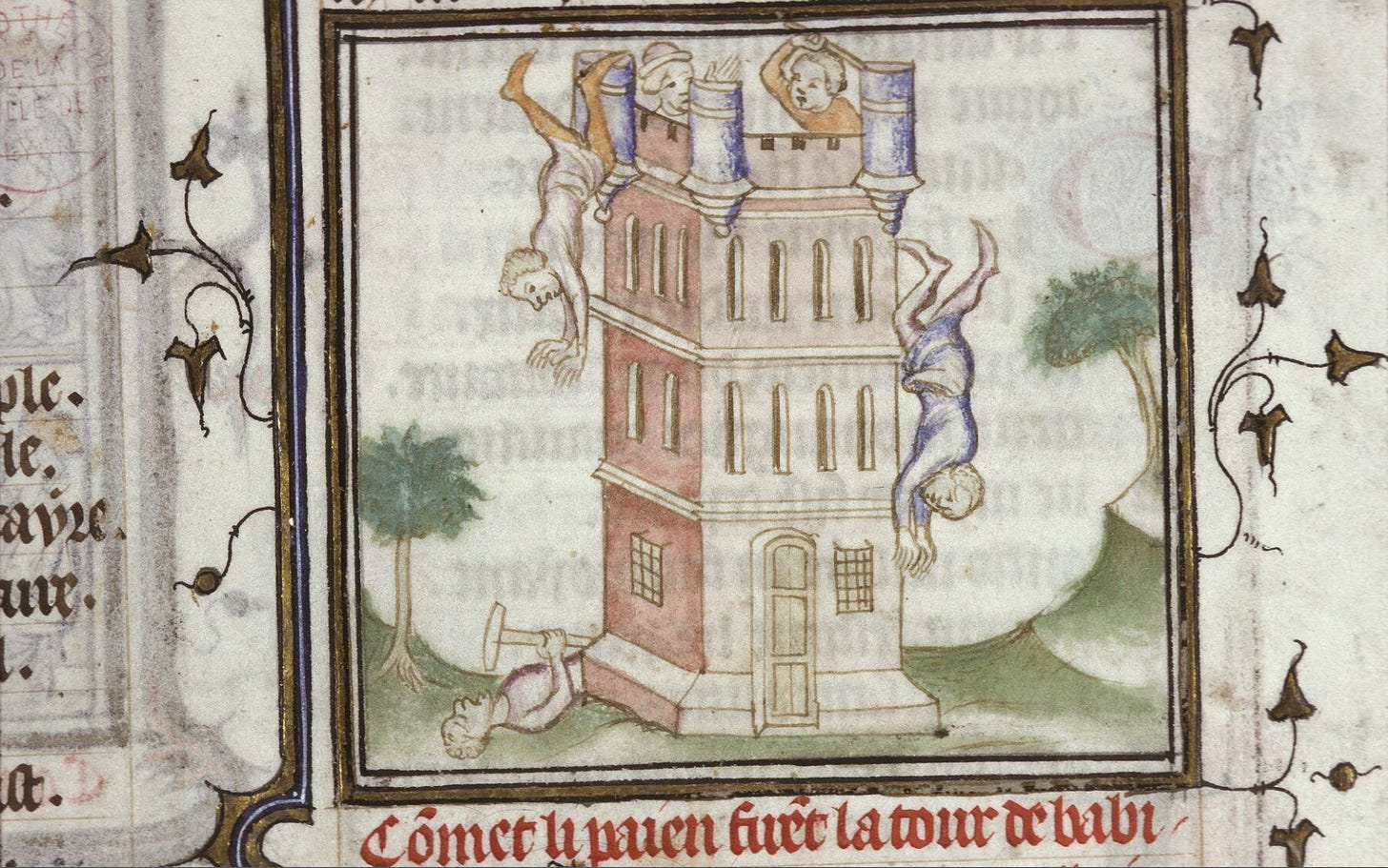
His argument is that the tower is really showing an earthquake and thus is one of the last seven plagues. Compare the top picture to the middle picture, which one is more likely to have informed the bottom picture? The one where you need to change almost everything or the one where you just needed to add a lightning bolt?
To give the ancestor images time to evolve into how they are represented in tarot he argued for a later date for most of the known decks. He argued that the 3-ring design and the fountain that Kaplan and Moakley cited to establish Francesco Sforza as the owner of the Pierpont-Morgan Bergamo deck were common and thus didn’t prove anything. Which is true for the most part however he ignored the Sforza lion on the King of Swords. After all, he did state in the books intro that he would present his theory like a lawyer defending a client. A lawyer is going to omit certain pieces of evidence that don’t fit their case. This is not a recipe for writing good history.
One part of his theory that I did find compelling was how he tied in the game of Emperor or Imperator as it was called in it’s original language. Imperator is game with only a few mentions that has confused historians and has still not been properly identified. It is thought to be related to the German game Karnoffel as another name for it was Kaiserspiel, literally the Emperor’s Game. As Bett’s theory is about a game based around a prophecy regarding the last emperor it would make since if this was that game. Alas there really is not a whole lot of evidence about this game to begin with and thus any discussion of it is highly speculative.
On the positives he did get a few card interpretations right. He noted that the Popess symbolized the church, she was Ecclesia, a common symbol for the church. The church is the pope’s wife after all. Of course the guy writing the Revelation book would come to this conclusion as Revelation uses this symbolism as well (below). If the Papess is the Church then the Empress represents the mother country.
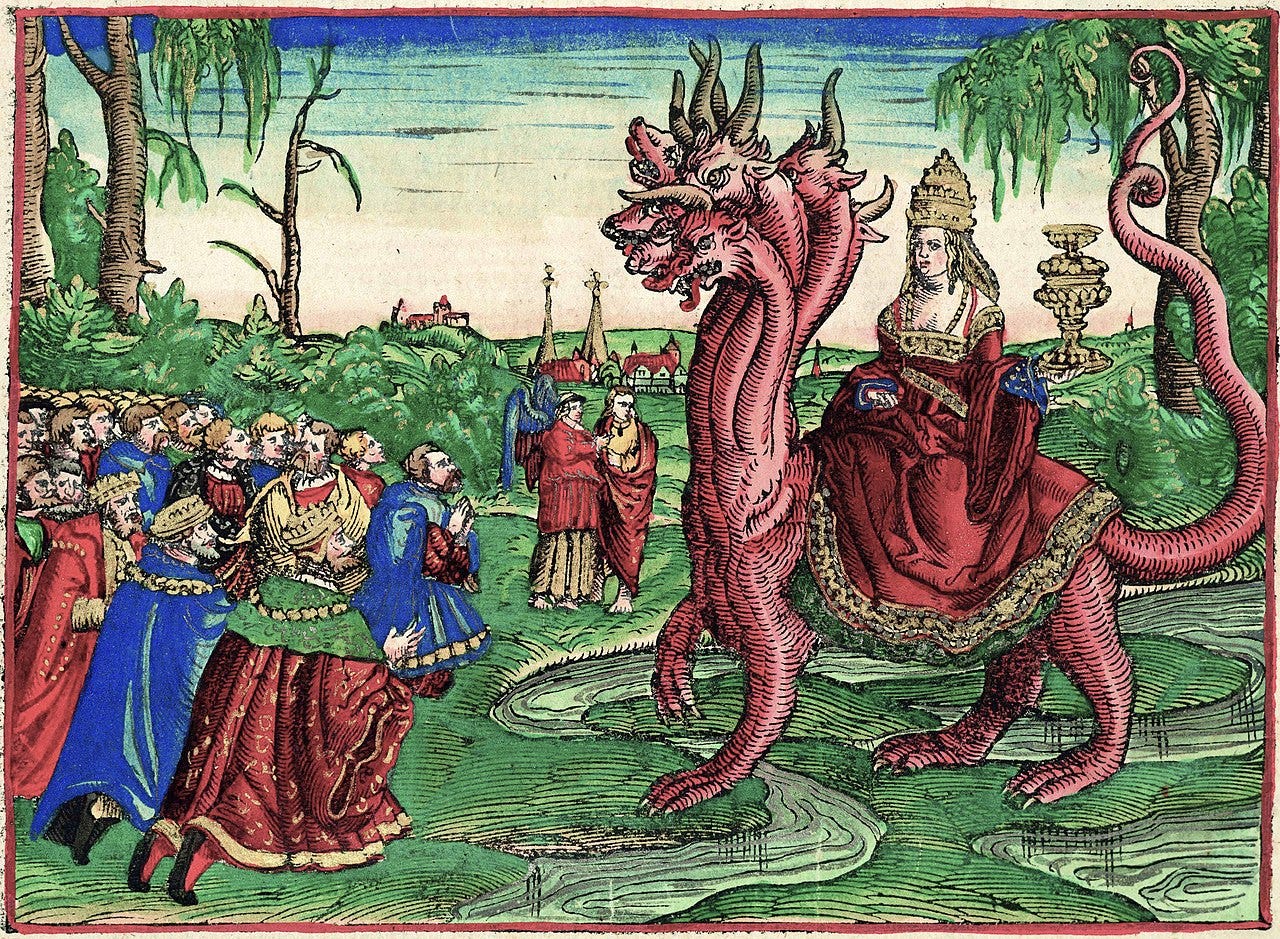
The research the book presented into medieval prophecies and the mendicant preacher tradition was also quite interesting. He theorized that St. Francis might be the Fool as he wore tattered clothes and traveled around however I strongly doubt such a revered figure would have been memorialized being bitten by dogs and have his dick hanging out.
Despite it’s flaws this was a fun read and did present a novel theory. While the last act of the trump sequence is obviously informed by Revelation, the author got a bit carried away thinking he had made a discovery with the Ancestor manuscript. Though he perhaps was the first to figure out the symbolism of the Papess.
So there you have it folks, Hunting the Unicorn III - a tale of 3 duds. But we are now through the long, dark middle because in the next installment we will be discussing 3 of the best books that I have read on this subject:
Paul Huson, Mystical Origins of the Tarot: From Ancient Roots to Modern Usage (2004)
Robert M. Place, The Tarot: History, Symbolism, and Divination (2005), Archive
Ronald Decker, The Esoteric Tarot: Ancient Sources Rediscovered in Hermeticism and Cabalah (2013)
See you next time in Hunting the Unicorn IV - The Masters of Tarot





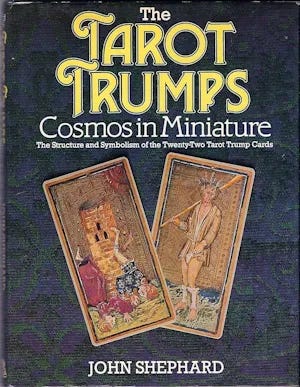







How I love a good investigation ! I feel like Harry Potter looking for the Horcruxes... As a side note, I love the idea of the Popess symbolizing the church, and so being the "Pope's wife".
Can't wait to read the next installment !